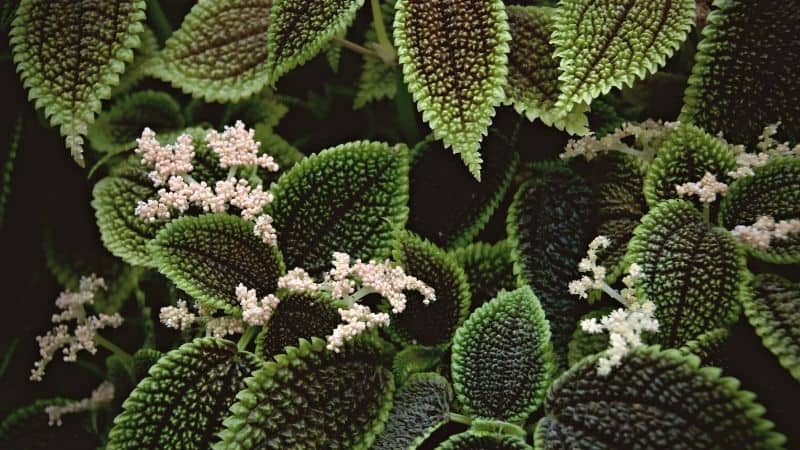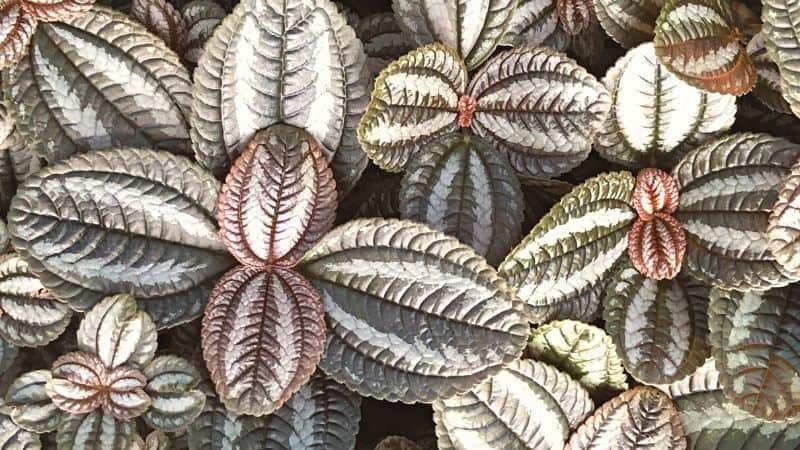Pilea Involucrata, otherwise known as the Friendship Plant, is native to humid and tropical environments. Mainly found in Central and South America, it is known as the Friendship Plant because of the ease it can be bred and divided with other gardeners.
Its patterned leaves feature a deep green on top and luscious red on the underside. The Friendship Plant is particularly unique in that of the 100s of species of Pilea plants; this one does very well being grown indoors. In the springtime, one can look forward to small pink or green flowers amidst their unique leaves.
Pilea Involucrata Care Guide Overview
- How To Plant (when & where)
- How To Grow (staking, watering, fertilizing, humidity, mulching)
- How To Trim And Prune
- How To Pot And Repot
- How To Propagate (when & how)
- And Pests and Diseases, Plant Species, Toxicity
Characteristics
- Scientific name: Pilea Involucrata
- Common names: Friendship Plant, Panamiga, Moon Valley Plant
- Origin: Native to Central and South America
- Indoor or Outdoor Plant: Can grow well indoors. Grows outdoors in native, humid environments.
- Height; Structure: Up to 12 inches tall, Also grows to a width of approximately 12 inches if given enough space to spread. Individual leaves are one to three inches long.
- Temperature: A warmer setting with a minimum of 65F(18C) and a maximum of 80F(27C).
- Flower color: Pink or green during Spring months
How To Plant The Pilea Involucrata

Friendship plants can thrive perfectly well indoors as long as they have ample indirect sunlight, a warm/humid environment, and moist soil. It is ideal rotating a potted Friendship Plant every few days to ensure even exposure to sunlight. In its native home, Pilea Involucrata grows on the outskirts of forests with tropical climates. Terrariums also make perfect homes for this species of plants because they closely resemble the environment it originates from.
Planting Time
Warmth and humidity will create an ideal home for this foliage. They do not tolerate cold or overmoisture well but are otherwise adaptable. If kept as an indoor plant, growing them may start at any point. They grow at a moderate to fast rate, but repotting isn’t necessary unless the roots become densely tangled. When this occurs, the pot size should increase by another one to two inches.
Spacing
Six to nine inches will suffice when planting Friendship plants. If being grown near their mother plant, they will spread horizontally to put out new stems.
Light
In its native home, Pilea Involucrata grows best in the shade. Indirect sunlight is perfect for this species. It grows along the forest floor, which allows other trees to block some of the light.
When raising indoors, 6-8 hours of indirect light is prime. If placed near a window sill, rotating the plant every few days will allow equal sunlight on all sides. Otherwise, it will lean toward the direction light is coming from as it gets bigger.
Soil
The optimum soil for a Friendship Plant is rich and well-draining. Too much moisture is not healthy for this plant, so an option that doesn’t oversaturate is best. African Violet potting mix is a common choice for potting a Friendship Plant.
To increase aeration, consider options such as peat moss or coco noir. Compost works well for fertility but use sparingly.
How To Grow the Pilea Involucrata

Growth Habits
Pilea Involucrata rarely reaches over 12 inches in height. They do spread slowly and will grow stems across the ground if planted around their mother plant. The maximum height will generally take 3-5 years to achieve.
If planting a new stem from clipped tips, it is best to do in the springtime when the weather is more suitable. Cuttings typically root smoothly and form in just a few weeks. They grow best in 4″ pots or planters to maintain a restriction.
Staking
Staking is usually not necessary because a Friendship Plant does not grow excessively tall. When the weight of it causes the stem to bend and grow at an angle, staking may be used.
Watering
Friendship Plants are not high maintenance when it comes to watering. The best rule of thumb is to wait until the top inch of soil is dry before adding more water. Once watered again, let it drain and keep an eye on the top inch.
If overwatered, Friendship plants die in those conditions. Of course, the opposite is harmful as well. Underwatering will cause the leaves to begin wilting and fall off.
Fertilizing
Fertilizing should be done twice a year- in Spring and again halfway thru Summer. Dilution to half strength or quarter strength is optimum for growth.
Excellent options for assistance in fertilizing are earthworm castings, perlite, or bark.
Humidity
Humid conditions that range from 60-90% replicate the environment Pilea Involucrata thrives in. This is why a terrarium is considered an ideal growing environment for this species.
Friendship plants do not do well in cooler temperatures. It is best to ensure that air remains at a warmer temperature.
Trimming and Pruning
A Friendship Plant may need pruning for several reasons:
- It is becoming overgrown.
- The shape is not looking quite right.
- It is not showing signs of growth despite otherwise proper care.
Rather than cutting, Friendship Plants are pinched, which only requires using one’s fingers. This is the time to remove any dead leaves or any overgrowth.
Potting and Repotting
Pilea Involucratas do well in a pot of about 4″ to restrain growth at the onset. Repotting is usually only needed biannually, or if the roots become overgrown. If this is the case, a pot of one to more inches in diameter is recommended.
Propagation
The three main types of propagation for Friendship Plants are seeds, stem-tip cuttings, and stem division.
If using stem division, it is best to water the soil 24 hours before- avoiding transplant shock. Separate the selected portion by pushing the stem downward until a snap is heard.
Two to three stem-tip cuttings should be placed in a 3-4″ pot facing upward. A plastic bag may be sealed around the newly potted cuttings to hold in humidity. New plants will be growing within several weeks.
Pests and Diseases
Friendship Plants are not magnets for critters but some may be found occasionally. Spider mites and mealybugs are the biggest offenders and may hide within the crevices of the plant. Catching them early is key.
Root or stem rot is most common in an ill Friendship Plant. Overwatering will cause this. Leaf spot is another indicator that a plant has been infected. It is recommended to isolate the plant and remove the affected leaves to avoid further spread.
Plant Species
There are over 600 types of Pilea plants. The Pilea Involucrata can be chosen as an accent plant or a standalone piece. It will flourish indoors or outdoors and does not require a lot of upkeep.
Within the Pilea family, Pilea Cadierei and Pilea Repens are most similar with the same leaf shape and reddish coloring on the undersides.
Toxicity
Friendship plants are not considered toxic to humans or animals.
Final Thoughts
Pilea Involucrata is ideal for anyone wanting a low-maintenance plant that maintains its beauty through simple care. If someone is a new plant enthusiast, this is a great starter choice.


